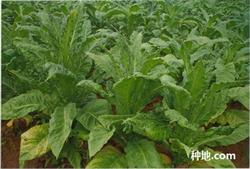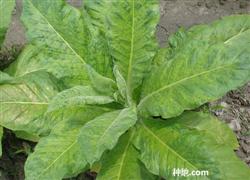How to control tobacco mosaic disease?

How to prevent tobacco mosaic disease? Tobacco mosaic disease is one of the three major tobacco diseases, which occurs widely in all tobacco areas of our province. The disease can reduce yield by 30% and economic loss can reach 50%-70% in seedling or early field stage, and has little effect on yield after topping, but has great effect on quality. The disease is caused by a variety of viruses, mainly common mosaic disease and cucumber mosaic disease in production. 1. Symptoms 1. Common mosaic disease: infected by virus, young leaves begin to develop first, mesophyll color along the veins turns yellow, and bright veins appear. Then dark or light part gradually expanded, forming yellow and green mottled (mosaic); severe leaf thickness uneven, forming blisters, leaf margin to the back curl, leaf shrinkage distortion, was abnormal, there were notches or bands. Early onset, serious dwarfing of plants, shortened internodes, no trees, no leaves. 2. Cucumber mosaic disease: infected by the virus damage, the initial onset of transparent veins, after the change of mosaic, narrow leaves, distortion, surface hair loss, loss of luster. Some diseased leaves often curl upward, some appear yellow-green or dark green spots, some appear brown necrosis of lateral veins, or dark brown lightning-like necrosis along veins. The plant obviously dwarfs, the root system development is bad, -the dead part leaf often appears "the mosaic burns the spot". 2. Pathogenesis 1. Common mosaic disease: The virus can survive for a long time in the sick body. It is mainly mixed with soil, fertilizer, seeds and other sick bodies as well as some poisonous hosts such as tomato, rape, mustard or perennial weeds. Spread by juice contact, that is, from mechanical friction micro-wound invasion of the host, through people, wind, insects and other media for transmission: seedbed period to prosperous long-term susceptible disease, after topping resistance increased. The temperature of 18-30℃ is most suitable for the disease. The disease was serious in tobacco fields near villages and towns, tobacco houses, purchasing sites, roadside, vegetable fields and fields used as tobacco fields and vegetables before transplanting. 2. Cucumber mosaic disease: This virus does not survive in dried tobacco leaves under natural conditions. It mainly overwinters in winter vegetables, vegetable seed plants or perennial weeds. In the spring of the following year, it was mainly spread by tobacco aphids. Therefore, the more weeds, tobacco fields near cucumber, tomato and other vegetables, high temperature and drought, aphid occurrence is large, the disease is serious. Too much nitrogen fertilizer, poor soil, hardening, sticky heavy, the disease is also heavy. 3. Control techniques 1. Select high-yield and disease-resistant varieties. Such as Kirk 176, K394, g346, K326 and NC series and other varieties. 2. Optimize seedbed, reasonable rotation. Seedbed should choose good soil fertility, shelter from the wind and sun, convenient irrigation, as rice and away from the vegetable field, baking house, drying shed field block. At the same time, tobacco-rice rotation should be implemented in the field, which can greatly reduce pathogens and reduce harm. 3. Soil disinfection. Combined with winter tanning. Seedbed can generally be used for incineration disinfection, seriously ill areas can be fumigated with methyl bromide, and at the same time select nutrient soil. Field can be disinfected with 60 kg lime. All can eliminate the source of disease, pests, weeds in the soil. 4. Strengthen cultivation management. Timely early sowing and early planting, single ridge high ridge cultivation, breeding disease-free seedlings; reasonable fertilization, scientific water management, promote early growth and rapid development, enhance the disease resistance of planting spiders. 5. Clean the countryside, cultivate and weed in due time. Remove the leaves, rotten leaves, diseased leaves, small leaves, etc. in the field in time, eradicate the weeds around the countryside and burn them in a centralized manner; it is prohibited to use farm manure with toxic tobacco plant residues, tobacco debris, tobacco stalk ash and garbage soil in front of and behind the house as nutrient soil or fertilizer for tobacco fields. At the same time, attention should be paid to field operation, which should be carried out in the order of healthy plants first and sick plants later, and mechanical damage should be avoided to reduce artificial contact transmission. After the harvest of tobacco leaves, all tobacco fields should be completely cleaned, and tobacco stems and diseased plant residues should be burned in a centralized manner to eliminate pathogens. 6. Timely control aphids, cut off the source of poison. 40% omethoate 1000-1500 times solution or 20% mepramine 3000--4000 times solution, 50% pirimicarb 800-1500 times solution can be selected for spraying. High temperature, dry weather, aphids large number of continuous spraying control. At the same time, silver plastic film cultivation can be popularized. Silver film has obvious effect on aphid drive, which is beneficial to avoid the susceptible stage one month after transplantation. 7. Chemical control. Spraying pesticide once in big cross stage, seedling stage and seedling stage of field. The medicine can be sprayed with 500 times solution of 20% virusin B or 800 - 1200 times solution of 1.5% Zhibingling, 1% virus inhibitor and 100 times solution of 83-1 inhibitor. Click for more tobacco growing technology Click for more flower growing technology
- Prev

How to prevent and cure tobacco cucumber mosaic disease?
How to prevent and cure tobacco cucumber mosaic disease? Cucumber mosaic disease is the most common and widespread tobacco virus disease. The virus is mainly transmitted by aphids and spreads with the migration of aphids. The disease generally occurs in the seedling cluster stage after tobacco seedling transplanting, which often leads to the stagnation of plant growth and development and affects the yield. ...
- Next

What is tobacco mosaic disease?
What is tobacco mosaic disease? There are two symptoms of tobacco mosaic disease. 1. Common mosaic disease: infected by the virus, the tender leaves begin to develop the disease first, and the mesophyll along the veins turns yellow and bright veins appear. Then the dark or light color parts gradually expand to form yellow and green mottled (mosaic); in severe cases, the leaves.
Related
- Fuxing push coffee new agricultural production and marketing class: lack of small-scale processing plants
- Jujube rice field leisure farm deep ploughing Yilan for five years to create a space for organic food and play
- Nongyu Farm-A trial of organic papaya for brave women with advanced technology
- Four points for attention in the prevention and control of diseases and insect pests of edible fungi
- How to add nutrient solution to Edible Fungi
- Is there any good way to control edible fungus mites?
- Open Inoculation Technology of Edible Fungi
- Is there any clever way to use fertilizer for edible fungus in winter?
- What agents are used to kill the pathogens of edible fungi in the mushroom shed?
- Rapid drying of Edible Fungi

